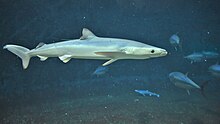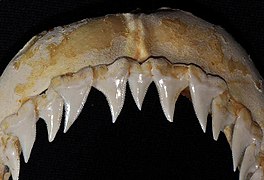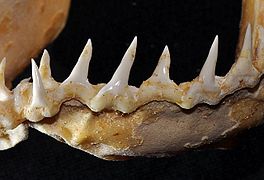Blue shark
| Blue shark Temporal range: Miocene-recent
| |
|---|---|

| |
| A blue shark in the Azores | |
| Scientific classification | |
| Domain: | Eukaryota |
| Kingdom: | Animalia |
| Phylum: | Chordata |
| Class: | Chondrichthyes |
| Subclass: | Elasmobranchii |
| Subdivision: | Selachimorpha |
| Order: | Carcharhiniformes |
| Family: | Carcharhinidae |
| Genus: | Prionace Cantor , 1849
|
| Species: | P. glauca
|
| Binomial name | |
| Prionace glauca | |

| |
| Range of the blue shark | |
The blue shark (Prionace glauca), also known as the great blue shark, is a
Although generally
Anatomy and appearance
Blue sharks are light-bodied with long
-
Jaws
-
Upper teeth
-
Lower teeth
Reproduction

They are viviparous, with a yolk-sac placenta, delivering 4 to 135 pups per litter. The gestation period is between 9 and 12 months. Females mature at five to six years of age and males at four to five. Courtship is believed to involve biting by the male, as mature specimens can be accurately sexed according to the presence or absence of bite scarring. Female blue sharks have adapted to the rigorous mating ritual by developing skin three times as thick as male skin.[4]
Ecology
Range and habitat
The blue shark is an oceanic and
Feeding
Squid are the most important prey for blue sharks, but their diet includes other invertebrates, such as cuttlefish, blanket octopuses, and pelagic octopuses, as well as lobster, shrimp, crab, a large number of bony fishes (such as long-snouted lancetfish, snake mackerel and oilfish), small sharks, mammalian carrion and occasional sea birds (such as great shearwaters).[14] Whale and porpoise blubber and meat have been retrieved from the stomachs of captured specimens and they are known to take cod from trawl nets.[4] Sharks have been observed and documented working together as a "pack" to herd prey into a concentrated group from which they can easily feed. Blue sharks may eat tuna, which have been observed taking advantage of the herding behaviour to opportunistically feed on escaping prey. The observed herding behaviour was undisturbed by different species of shark in the vicinity that normally would pursue the common prey.[15] The blue shark can swim at fast speeds, allowing it to catch up with prey easily. Its triangular teeth allow it to easily catch hold of slippery prey.
Predators
Young and smaller individuals may be eaten by larger sharks, such as the
California sea lions (Zalophus californianus), Northern elephant seals (Mirounga angustirostris) and Cape fur seals (Arctocephalus pusillus pusillus) have been observed to feed on blue sharks.[18][19]
Relationship to humans

Blue shark
for their beauty and speed.Blue sharks rarely bite humans. From 1580 up until 2013, the blue shark was implicated in only 13 biting incidents, four of which ended fatally.[21]
In captivity


Blue sharks, like most
The blue shark that survived the longest in captivity was captured in Shizugawa Bay on July 27, 2018, and taken to the Sendai Umino-Mori Aquarium.[26] The total length at the time of delivery was 51 cm (1.67 ft), the estimated weight was 0.345 kg (0.76 lb), and the age was about 1 year old.[26] After that, it lived for 873 days, but died due to factors such as disordered swimming due to dehydration.[26] At the time of death, the total length was 114 cm (3.74 ft) and the weight was 4 kg (8.8 lb).[26] This growth rate is said to be the same as that of wild blue sharks.[26]
Blue sharks are relatively easy to feed and store in captivity, and the three primary issues appear to be transport, predation by larger sharks and trouble avoiding smooth surfaces in tanks.[22] Small blue sharks, up to 1 m (3.3 ft) long, are relatively easy to transport to aquaria, but it is much more complicated to transport larger individuals.[22] However, this typical small size when introduced to aquaria means that they are highly vulnerable to predation by other sharks that are often kept, such as bull, grey reef, sandbar and sand tiger sharks.[22][23] For example, several blue sharks kept at Sea World San Diego initially did fairly well, but were eaten when bull sharks were added to their exhibit.[23] Attempts of keeping blue sharks in tanks of various sizes, shapes and depths have shown that they have trouble avoiding walls, aquarium windows and other smooth surfaces, eventually leading to abrasions to the fins or snout, which may result in serious infections.[22][23] To keep blue sharks, it is therefore necessary with tanks that allow for relatively long, optimum swimming paths where potential contact with smooth surfaces is kept at a minimum. It has been suggested that prominent rockwork may be easier to avoid for blue sharks than smooth surfaces, as has been shown in captive tiger sharks.[22]
Conservation status
In June 2018 the New Zealand Department of Conservation classified the blue shark as "Not Threatened" with the qualifier "Secure Overseas" under the New Zealand Threat Classification System.[27] The species is listed as Near Threatened by the IUCN.[2]
See also
References
- ISBN 9780877104506. Archived from the originalon 10 May 2012. Retrieved 9 January 2008.
- ^
- ^ a b Froese, Rainer; Pauly, Daniel (eds.) (2006). "Prionace glauca" in FishBase. 9 2006 version.
- ^ a b c d e f Compagno, Leonard J. V. (1984). Sharks of the World: An annotated and illustrated catalogue of shark species known to date (PDF). Food and Agriculture Organization of the United Nations. pp. 521–524, 555–61, 590.
- ^ Sharks, Emerging Species Profile Sheets, published by the Department of Fisheries and Aquaculture, Government of Newfoundland and Labrador in Emerging Species Profile Sheets. Department of Fisheries and Aquaculture, Canada. Archived October 7, 2013, at the Wayback Machine
- ^ a b FLMNH Ichthyology Department: Blue Shark Archived 2013-05-17 at the Wayback Machine. Flmnh.ufl.edu. Retrieved on 2012-12-19.
- ^ Blue Shark (Prionace glauca) – Ireland's Wildlife Archived 2013-04-21 at the Wayback Machine. Irelandswildlife.com (2011-07-21). Retrieved on 2012-12-19.
- ^ Sharks – Greenland (Somniosus microcephalus), Shortfin Mako (Isurus oxyrinchus), Blue Shark (Prionace glauca), Basking Shark (Cetorhinus maximus), and Porbeagle (Lamna nasus). Archived October 7, 2013, at the Wayback Machine fishaq.gov.nl.ca
- ^ Sea Angling in Ireland – Blue Shark. Sea-angling-ireland.org (2006-10-21). Retrieved on 2012-12-19.
- ^ Summary of Large Blue Sharks Prioncae glauca (Carl Linnaeus, 10th edition of Systema Naturae) in progress. elasmollet.org (March 2008)
- ISBN 978-3-540-30147-9.
- ISBN 978-0-520-94254-7.
- ISBN 0-00-713610-2.
- ^ "Prionace glauca (Blue Shark)". Animal Diversity Web.
- ^ Monique, Fallows (29 January 2013). "Blue Sharks Feeding on Anchovy Baitball". Apex Predators Blog. Archived from the original on 21 April 2013. Retrieved 6 February 2013.
- doi:10.1111/j.1748-7692.1996.tb00075.x. Archived from the original(PDF) on 12 July 2017. Retrieved 17 November 2016.
- S2CID 33831101.
- JSTOR 1380857.
- S2CID 2563222.
- .
- ^ Species Implicated in Attacks :: Florida Museum of Natural History. Flmnh.ufl.edu. Retrieved on 2016-11-17.
- ^ )
- ^ a b c d e f Blue Shark (Prionace glauca) in Captivity. elasmollet.org (2007)
- 河北新報. 24 June 2016. Retrieved 30 April 2021.
- ^ "ヨシキリザメ死亡について" (PDF). 17 December 2020. Archived from the original (PDF) on 14 March 2022. Retrieved 17 December 2020.
- ^ a b c d e "ヨシキリザメ№25について 仙台うみの杜水族館公式サイト". 24 January 2021. Archived from the original on 2 May 2021. Retrieved 1 May 2021.
- OCLC 1042901090.
External links
- "Prionace glauca". Integrated Taxonomic Information System. Retrieved 15 November 2005.
- Blue shark, Prionace glauca at marinebio.org
- "Blue shark, Prionace glauca" at the Encyclopedia of Life
- ARKive – Images and movies of the blue shark (Prionace glauca)
- Canadian Shark research laboratory
- BBCNews – 'Jaws' comes to a US beach 3 August 2010.
- BBCNews – Footage of shark which closed New Quay (Wales) beach 8 August 2012.
- Species Description of Prionace glauca at www.shark-references.com
- Photos of Blue shark on Sealife Collection
- Prionace glauca discussed on RNZ Critter of the Week, 12 August 2022




